#Maciste and the Headhunters
Explore tagged Tumblr posts
Text
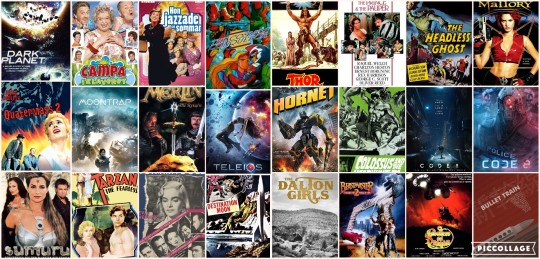
24 gott folk. Månadens gott och blandat innehåller 24 filmer för alla konnässörer av budgetfilm från skräphögen att botanisera bland. Vissa av dem är rentutav bra.
Beastmaster 2: Genom tidsbarriären / Beastmaster 2: Through the Portal of Time (1991). Okej, men långt ifrån bra uppföljare på klassikern "Beastmaster". Jag har lite svårt för när man plockar "hem" barbar- och fantasyfilm till "vår" värld.
Bloody Mallory (2002) [👍]. Franskt toppraffel, inte genial men helt klart en trevlig överraskning. Rekommenderas.
Bullet Train (2022) [👎]. Kul koncept. Rörig, småtråkig film med topnotch-SFX. Vad får jag för pengarna egentligen Hollywood?
Campa i klaveret (2012) [👍🔁🎭]. Klassiker från Vallarna. Claes Månsson i toppform!
Code 8 (2016) [👍]. Bra kortfilm som trots sin korta längd lyckas vara bättre än många av superhjältefilmerna från Marvel och DC jag sett.
Code 8 (2019) [👍]. Långfilmsversionen av filmen ovan. Man lyckades kanon med att utöka konceptet till full längd.
Cosmos Conqueror, the / Roboteu King (1981) [👎]. Värdelös animerad film från Sydkorea. Töntig dialog med en tillhörande engelsk dubb där "kobåjsigt" lär ha varit den genomgående regin. Bra signaturmelodi, enerverande musik för övrigt.
Dalton Girls, the (1957). Mjäh. Dålig karaktärsuppbyggad och slätstruken story. Drew Barrymore-filmen "Bad Girls" bygger på den här filmen. Man kan hoppa över bägge med äran i behåll.
Dark Planet (1997) [👍]. På gränsen till bra, och jag friar den hellre än fäller.
Destination Månen / Destination Moon (1950).
Fäkta för livet! / Prince and the Pauper, the (1977).
Headless Ghost, the (1959).
Hon jazzade en sommar (2002) [👍🔁🎭].
Hornet (2018) [👎]. Asylum mockbustern för storfilmen Bumblebee. Och det är det enda positiva som finns att säga om den.
I Dimma Dold (1953) [👍]. Bra svenskt morddrama i Agatha Christie-stil.
Maciste and the Headhunters / Maciste contro i cacciatori di teste (1963). Är den politiskt korrekt idag? Knappast. Men småskoj barbarfilm från Italien tackar man inte nej till.
Merlin: The Return (2000) [👎]. Störtlöjlig. Man vräker dessutom på med vitt ljus i scenerna att det är på gränsen till whitewashing.
Moontrap: Target Earth (2017) [👎]. Har inte sett filmen den är en uppföljare till.
Quatermass 2 (1957).
Star Knight / El caballero del dragón (1985) [👍]. På sina ställen lite udda, men klart en trevlig film i övrigt.
Sumuru (2003) [👍🔁].
Tarzan den orädde / Tarzan the Fearless (1933).
Teleios (2017) [👍]. Ohh. Lågmäld SF med ett budskap men som inte skriver tittaren på näsan.
Thor the Conqueror / Thor il conquistatore (1983) [👎] En sådan där film man måste läsa synopsiet efteråt för att få ihop storyn om vad som pågick.
Väldigt många av månadens filmer är fyndade på Prime Video, ett par på Netflix och en hel hög på tuben som vanligt. SVT Play har två representanter. Håller er undan från Cosmos Conqueror och satsa istället på Bloody Mallory eller om man föredrar engelska Dark Planet eller Teleios. Vill man se superhjältefilm men tröttnat på actionsekvenserna signerade Marvel rekommenderas Code 8.
#senast sedda filmer#månadens filmer#Beastmaster 2: Genom tidsbarriären#Beastmaster 2: Through the Portal of Time#Bloody Mallory#Bullet Train#Campa i klaveret#Code 8#Code 8 short#the Cosmos Conqueror#Roboteu King#Dalton Girls#Dark Planet#Destination Månen#Destination Moon#the Fäkta för livet! / Prince and the Pauper#the Headless Ghost#Hon jazzade en sommar#Hornet#I Dimma Dold#Maciste and the Headhunters#Maciste contro i cacciatori di teste#Merlin: The Return#Moontrap: Target Earth#Quatermass 2#Star Knight / El caballero del dragón#Sumuru#Tarzan den orädde#Tarzan the Fearless#Teleios
11 notes
·
View notes
Photo
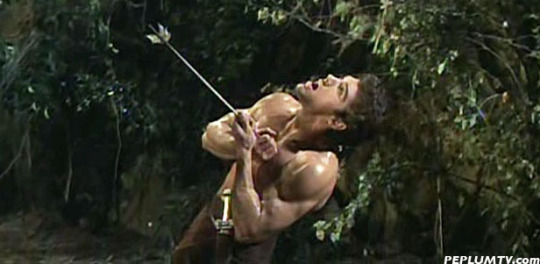
(via PEPLUM TV: Musings!)
Maciste (Kirk Morris) gets the point in COLOSSUS AND THE HEADHUNTERS (1963)
11 notes
·
View notes
Text
“maciste! maciste! macis—” dammit movie don’t promise me a cheesesteak and then supply me with zero cheesesteak!!
#the joke is that maciste sounds like ‘my cheesesteak��#for those of you who haven’t seen colossus and the headhunters#mystery science theater 3000
1 note
·
View note
Photo

605: Colossus and the Headhunters
I usually find the Hercules/Maciste episodes of MST3K to be pretty good fun, and as you could probably tell from the number of similar films I’ve used as Episodes that Never Were, I do enjoy the genre. It was therefore a surprise to realize I hadn’t seen Colossus and the Headhunters in literally years, and I wondered why not. The answer? I think it’s because it’s honestly kind of dull.
As the movie begins, some unfortunate cave people are crushed when a volcano showers them in styrofoam boulders. Whether they have anything to do with the more Greco-Roman folks we see in the speaking roles, I don’t know – but mere moments after young Ario’s dying father charges him with finding their people a new home, Maciste shows up! He leads them to his raft on the beach, and they set sail as the whole island falls apart. I hope that wasn’t supposed to be Atlantis. It wasn’t nearly impressive enough to be Atlantis.
Anyway, they decide to head for the land of the Uriels, where there’s supposed to be a city of gold. Some undetermined amount of time later, they get there, but there’s no golden city waiting for them, just a tribe of guys in kerchiefs who shoot Maciste and take everybody else prisoner. This is merely a misunderstanding, however – these are the Uriels, whose city of gold was taken over by the evil Kermes with the help of his following of Headhunters! At first Maciste isn’t interested, since he doesn’t want to take on a new project until he’s done saving the island people, but when the Headhunters attack the Uriel camp, he can’t just leave them to be slaughtered.
I love the name Kermes. It sounds like something you’d get if The Muppet Show put on a sketch about Greek mythology. Mighty Gonzeus rules Olympus, with his brother Fozzeidon and his messenger Kermes! Actually, there are a lot of amusing names in this one. If the hero is My Cheesesteak, then the deposed king is Honey Badger, and IMDB insists there’s a character named Gunk.
There are a number of other rather cynical observations I find myself making while watching this movie. One is that, despite the fact that nearly all the cavemen we saw killed in the opening were male, there seem to be at least twice as many men as women among the refugees – both the island people and the Uriels. This could be a problem for both groups.
Then there’s the fact that the movie can’t make up its mind just how strong Maciste is. When he’s shot by an arrow he pulls it out and then just walks away despite the blood pouring down his chest, and in scenes no more than a day or so later, he’s completely healed. Yet just two or three opponents can keep him busy enough to allow Kermes and his toady to escape? But wait, in the final battle he takes on ten at a time with ease? He couldn’t bend the metal bars of a portcullis, but he finds his way into the prison chamber beyond by punching through a stone wall? And how the hell did he miss the giant lever that raises the portcullis, anyway?
The dialogue is remarkably inane. Most of the lines seem to be things like, “don’t worry, it’ll be all right,” “we’re being defeated,” and “be quiet.” The English dubbing is half-assed at best, never matching the lip movements and voiced without enthusiasm. The costumes are ridiculous. Most of the island people wear brightly patterned loincloths. The Uriel priest wears a diaper on his head and Amoa sports a series of silly costumes, some of which she has visible trouble walking in.
When I reviewed Goliath and the Vampires, I noted that Maciste movies were rarely in continuity with each other – this is a fine example. It was made by the same director as Fire Monsters Against the Son of Hercules just a year later, and in fact the opening volcanic eruption is lifted from the earlier movie. In Fire Monsters Against the Son of Hercules, Maciste was played by a guy named Reg Lewis, who walked off into the sunset with Princess Moa at the end. In Colossus and the Headhunters, our hero is Kirk Morris, who leaves at the end with a different girl. No attempt is made to even pretend the two stories happen in the same universe. Indeed, Colossus and the Headhunters might almost be a remake!
Consider: both stories concern a group of refugees who aren’t much welcome in their new home. The locals are ruled by a usurper, aided by members of a third tribe rather more savage than the other two, while the deposed queen quietly refuses to marry him. Maciste is able to bring about peace between the two groups by saving them both from disaster, and at the end the queen runs off with him instead of taking her place as ruler, I guess because girls would rather give blow jobs than orders.
If Colossus and the Headhunters is just a second stab at Fire Monsters Against the Son of Hercules, then we should probably ask if it’s any better. Well… sort of. There are no terrible felt monsters in this one, and the things that go on are slightly less ridiculous, but in a way that actually hurts the movie. If you read my review of Fire Monsters Against the Son of Hercules, you’ll remember that it was bad enough to be downright hilarious. Colossus and the Headhunters has significantly less in it that’s over-the-top enough to be funny. There are breathing corpses, plastic skeletons, and a cosmetology class’ mannequin head on top of a pole, but it’s not quite corny enough to get a laugh. People topple off a rope bridge into a river, but they’re not dramatic enough to be funny (though Maciste’s reaction to getting hit with an arrow is pretty close). The dubbing is bad, but not amusing-bad, and so on.
In a couple of others ways, Colossus and the Headhunters is significantly worse, for example in its portrayal of cultures. In Fire Monsters Against the Son of Hercules, the Sun and Moon tribes were quite simplistic but they were internally consistent and you could sort of see how each one worked. In Colossus and the Headhunters we meet three different peoples, none of whom even come close to that. The island people, of course, we barely see – they flee their homeland and then most of them vanish while only Ario accompanies Maciste to save the Uriels. The headhunters are stock savages in briefs and warpaint, so the only ones we get to see very much of are the Uriels themselves.
We don’t exactly see them at their best, of course – their golden city is in ruins and the remnants of their people are hiding in the woods or living in tents in a field. What we do see, however, is a weird mix of motifs that never manages to gel. There are Grecoey-Romany elements, particularly in the costumes, but the artefacts range from the pseudo-medieval to the pseudo-Aztec, while many of the names (such as Amoa) sound almost Polynesian. Then there’s stuff like the ridiculous purple tutu Amoa’s handmaiden (her name is Moana, and the last time I watched this episode was so long ago that wasn’t funny yet) wears to dance at her mistress’ wedding, which doesn’t belong in any sort of ancient past.
Also, Fire Monsters Against the Son of Hercules was actually about its two peoples and what happened when they found themselves competing for resources. In Colossus and the Headhunters, the island people who are first to be introduced are ultimately irrelevant. For most of the story they’re off hiding somewhere while Maciste takes time out to help the Uriels. Only Prince Ario sticks around, and he never does anything of importance. Why are they even in this movie? The only thing that would be missing without them is about fifteen minutes of screen time.
There’s no shortage of things that time could have been better spent exploring. For example, they could have thrown in some actual development to the romance between Amoa and Maciste, which comes out of nowhere. He is captured and brought to her tent, where she tells him about the prophecy that a man will come from the sea to solve all the Uriels’ problems. Maciste protests that he can only save one civilization at a time, and Amoa calls him a coward. The next time she sees him is after he came back to save her father, and she immediately confesses her undying love. I guess he’s been kind of heroic by then, but even before that she’s talking about him to her handmaiden and implying she’s already in love with him.
At the end, Amoa swims out to Maciste’s little raft and heads off to sea with him, even as he begs her to stay behind. This isn’t the ending we want for Amoa – after Kermes earlier mocked her by telling her he was the only one who could give her a throne, and that the ‘delicate shoulders of a woman’ could not bear the burden of rule, we want to see her take her rightful place as Queen of the Uriels. Other characters nod sagely and say she might be back someday, but it’s still kind of a letdown, as if Kermes was right and girls just aren’t up to the job of politics.
My overall feeling about Colossus and the Headhunters is that it’s pretty blah. It’s neither good enough nor bad enough to be entertaining – the MST3K commentary livened it up a lot, but without it, it’s not really worth the effort. This one really needed a couple of guys in cheap monster suits to liven it up.
25 notes
·
View notes
Text
CIBIRIA (1914)
This is an early Italian silent that influenced directors such as D.W. Griffith (Intolerance) and Fritz Lang (Metropolis). Set in Rome during the Carthagian Wars, it begins with the eruption of Etna and ends with a romantic scene on a boat returning to Rome after Roman forces capture Carthage. Much of the action of the movie focuses on Sophonisba (princess of Carthage) and her promised marriages to rival suitors, the life of Cabrina (a roman girl who ends up as a Carthagian slave girl and promised sacrifice to Molach), and the adventures of Flavius and his giant companion Maciste (Roman spies in Carthage). Betrayal and redemption are played out many times. The movie is not without controversy—Gabriele d'Annunzio (early Fascist) co-wrote the movie. Cibiria was seen as helping to promote efforts to return Italy to the glory of Rome, contributing to the rise of Mussolini. On a different tangent, the character Maciste returned in a number of sword and sandal movies including Colossus and the Headhunters (in Italian: Maciste contro i cacciatori di teste)—which I recently saw thanks to the folks of MST3K,
0 notes
Photo
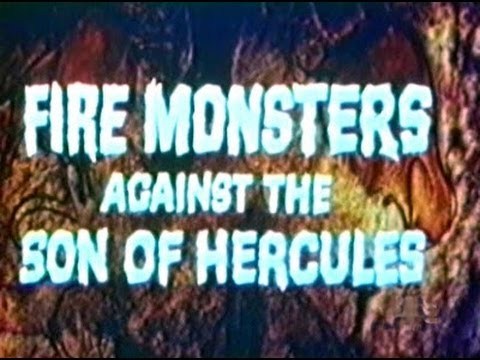
Fire Monsters Against the Son of Hercules
This here Sword-And-Sandal epic was directed by Guido Malatesta, who wrote the screenplay for Colossus and the Headhunters, and stars Margaret Lee, of Secret Agent Super Dragon; Luciano Marin, of Hercules and the Captive Women; and Andrea Aureli, of The Loves of Hercules. Clearly this one is fully qualified, even without the hilariously unconvincing monsters that peer out of every corner. My copy is an ancient VHS that looks like sun-baked shit and for some reason has no title card.
A tribe of cavemen, who I will call the Sun Tribe, are migrating south to escape the ice age. They reach the edge of the glacier, I guess, and build a village, but soon find themselves being menaced from multiple angles. There’s a stupid monster puppet living in the local lake, and another tribe already making their home nearby, the Moon Tribe, who have a strict anti-immigration policy. Lucky for them, Maxus the Son of Hercules happens to be in the area, and he’s all about fighting monsters and protecting the rights of refugees! Lots of people swing Styrofoam clubs and throw fake spears at each other, more terrible puppet things show up so Maxus can kill them, and I sit and think about how Cave Dwellers would be a much better title for this movie than it was for Cave Dwellers.
Holy fuck, you guys, this movie is so bad. It has its dull stretches but most of them don’t go on too long, and whenever something is actually happening it is hilariously awful. I could fill this whole review with a bullet list of the moments that made me laugh.
We’ll start with the dubbing, which critic Howard Hughes (not that Howard Hughes) described as the worst of all time. He clearly hasn’t seen Gamera vs Guiron but it’s still really bad. It’s not so much the performances, which are kind of crappy but no more so than in a thousand other lousy imported movies. It’s the lipsync, or rather, the lack thereof. Nobody made any effort to match the English dialogue to the way the actors’ mouths move. Sometimes it’s distracting. Sometimes it’s funny as hell. Sometimes it’s annoying. Sometimes it loops right back around to being funny again. The best part is that to re-release Maciste Contro i Mostri as Fire Monsters against the Son of Hercules, they had to dub the name Maxus over every occurrence of Maciste. The guy they hired to do so has a voice several notes higher than the original dub actor for Maciste, and introduces himself like he’s on a phone sex line.

The onscreen cast are pretty bad, too. The actors look like they belong in the ice age about as much as anybody in Deathstalker and the Warriors from Hell belonged in the Hyperborean. They’re all standing around dressed in fun fur and those cow rugs you can buy at IKEA, and they all look kind of awkward and embarrassed about it. Maxus has an amusing henna pompadour and his primary facial expression is the ever-popular smug smirk. The women wander around in fake leather miniskirts and bouffant hairdos like they have no idea what they’re doing here. The cannibal tribe wear little horns on their heads, like they’re Vikings who haven’t invented helmets yet.
The monsters are unbelievably bad. I can’t actually think of an adjective to describe how magnificently terrible they are. They’re the fakest, fabricky-est puppets I have ever seen in a movie. The first water dragon Maxus slays looks like a cheap plush toy version of that thing from The Neverending Story. Another is represented by stock footage of what I think is a perentie lizard, which is only seen in a cutaway because they couldn’t be bothered to back-project it. A three-headed cave dragon looks like a hand puppet you’d buy on eBay and leave a bad review about because it fell apart the moment you took it out of the box. It looks like it’s made of construction paper and felt. It makes The Loves of Hercules look like Jurassic Park. The screencap doesn’t do it justice. You’d need to see this thing in motion to truly understand just how stupefyingly shoddy it really is.

Oh, and despite the title of the movie being Fire Monsters, not one of these stupid things breathes fire. I am both disappointed and relieved, in that I would have loved to see it but if they’d tried it on this budget they would probably have burned their sets down.
This delicious chocolate icing of badness is slathered on the rich, gooey cake of what actually happens in the movie, almost all of which is ridiculous. Maxus fights a bunch of boneless water serpent creatures while the camera pays loving attention to his crotch. There’s a bit where several people theatrically lose their balance on a log bridge and fall into the ravine one after another, and it’s funnier every time. Maxus and his love interest get buried up to their necks as a form of punishment and people stand around throwing things at them but never hit them because nobody in this movie can aim. Then they’re freed by a random earthquake that just happens to split the ground right where they are. I was staying with my parents at the time I first saw this movie, and to keep from waking them up in the wee hours with my laughter I had to munch pillows like a vampire wedding night.
But I’m not here to laugh – or at least, not only to laugh – I’m here to analyze. Believe me when I say that very little in Fire Monsters against the Son of Hercules merits analysis, and even less is intended to be analyzed. The movie tries to set up a dichotomy between the two tribes. Our heroes, the Sun Tribe, worship fire and the sun god, live outdoors in wattle huts, and hold religious observances during the day. The bad guys, the Moon Tribe, worship the moon goddess, wear seashells and live in caves around an underground river, and sacrifice at night. Sun/Moon, Fire/Water, Day/Night, Peace/War, Light/Darkness, and to some extent Male/Female. It’s a list of opposites, so simplistic that I really can’t think of anything more to say than just to write them out. I doubt any deeper meaning was intended by it.
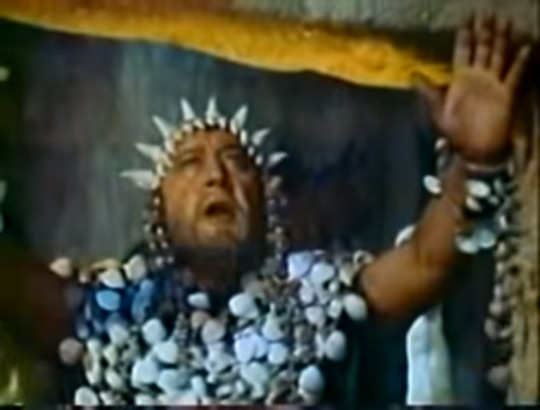
If I want something to actually talk about, Maxus never has an arc (I guess being the son of a demigod, he’s already perfect), but some of the minor characters do. The young chief of the Sun Tribe is supposed to be growing into that role, though he leaves most of the actual heroing to Maxus and it’s unclear how old he’s supposed to be (Luciano Marin was thirty-one when the movie was released). There is an interesting bit where he rails at the sun god for his misfortunes and is warned against it, but whether the gods actually exist or are active in this universe remains mysterious. It is true that a convenient eclipse halts a series of sacrifices, and that Maxus is saved by the volcano, but these could just be coincidences.
The odd thing about these two events, now that I think about it, is that while among the humans the Sun Tribe just want to live peacefully while the Moon Tribe wants to make war, their gods seem to have the opposite idea. If the eclipse (portrayed by effects people who clearly have no idea what an eclipse of the moon actually looks like) is the goddess’ doing, it is a frightening but peaceful intervention. Her worshippers asked for a sign, and she sent one that she does not approve. If the volcano is the work of the sun god, it is a catastrophic event that destroys the Moon Tribe’s home and livelihood, and kills many of the tribesmen. Not to mention that the main villain dies when the solar idol falls over and literally crushes him. Who’s advocating violence now?

I’ve gotten distracted, though. Getting back to the characters – the Sun Tribe’s leader is secondary not only to Maxus, but to Moa, the deposed rightful leader of the Moon Tribe. Moa probably gets more screen time than any other single character, and has the best claim, after Maxus, to main-character-hood. Her father and brothers have been murdered by the evil Fuan, who now wants to cement his claim to being legitimately in charge by marrying her, but she can’t stand him. I think she’s supposed to be one of those Strong Female Characters, but if so she’s a pretty half-assed effort.
For starters, while her introduction makes a big deal of her lost inheritance, she never does anything to try to reclaim it until Maxus turns up inside the caves. You’d think she could nurse a rebel cell biding its time or something, but all she does is sit on her shapely bottom and refuse to marry Fuan. I’m left with the impression that while she may be the obvious genetic heir, she actually doesn’t have any support base. The rest of the Moon Tribe prefers Fuan for some reason, and she’s left to sit there and pout and wait for a man to save her.
At the end of the movie, Maxus tells Moa that her job now is to make peace between her people and the Sun Tribe. One might expect the usual trope in which she does so by marrying the Sun Tribe’s leader, who is much more polite and less hairy than Fuan. He’s already got a wife, though, and saving her from the sacrificial block was a big part of his motivation. It’s no surprise, then, that Moa instead chooses to walk off into the sunset with Maxus. I guess she’s learned that nice girls don’t want political power.
That’s all pretty lousy, but the rest of the movie is all so deliriously fucking awful that there’s no point in taking it seriously, even as an example of shitty gender politics. Give this one a watch if you can. It’s a guilty pleasure, but a pleasure nonetheless.
#mst3k#reviews#episodes that never were#fire monsters against the son of hercules#my cheese steak#60s#we're running out of plots#curiously caucasian cavepeople
9 notes
·
View notes
Photo

Goliath and the Vampires
Like Colossus and the Headhunters or Hercules against the Moon Men, this was originally a Maciste movie. Exactly why the folks at Wild East Productions decided to call the hero Goliath when they dubbed it into English, I have no idea. Goliath was the bad guy, who got his ass whooped by a kid who threw a rock at him – even Bert I. Gordon knew that. But Goliath it is, so let's see what this movie has to offer.
Well, it's got Gordon Scott, the hero of Danger! Death Ray. It has large men in small skirts, soldiers getting thrown into barrels of water, a super-strong invulnerable guy who lifts heavy stuff and escapes prison by bending the bars, and an over-long sandstorm.. basically everything a sword-and-sandals movie needs to qualify for the Satellite of Love treatment.
As for the actual plot: our brawny protagonist comes home from a hard day of saving drowning children, only to find his village under attack by Vikings dressed as Mongols (watch the movie, you'll see what I mean). Goliath arrives too late to do anything but watch the bodies smolder, but he vows to follow the raiders to their homeland of Salmonak and save his girlfriend Julia from their clutches. Salmonak turns out to be a desert kingdom rather more Arabian than The Magic Voyage of Sinbad, and its people, from the meanest beggar to the Sultan himself, are slaves of the vampire Cobrak! Cobrak seeks to conquer the world with an army of the undead, but now that they've got Goliath on their side, perhaps the people of Salmonak can at last overthrow their literally bloodthirsty tyrant.
The... Viking Mongols? Mongol Vikings? I'm gonna call them Monglings. Most of them are undead, but we're not allowed to find that out until the movie's almost over, so they wear helmets to hide their semi-skeletal faces. These helmets are among thr most ridiculous pieces of so-called 'armor' I have ever seen on a screen. The men wearing them look like they're trying to cosplay a particularly impractical Final Fantasy character. I don't feel up to describing these things, so I'm going to have to show you.

That is a ridiculous note to begin a movie on. One of the top reasons I really hope this one gets into Shadowrama someday is because I would dearly love to see Crow and Servo try to move around while wearing those.
There's a lot to make fun of in Goliath and the Vampires. Besides those stupid helmets, there are the random dance numbers, one of which features a woman with spikes on her nipples, shimmying to what sounds like surf movie music. There's the dried-up husks of the vampire victims, propped against the walls or stacked up like lumber. The name 'Salmonak', which sounds like a yearly publication to predict what the fishing will be like. The bit where the Vizier meets his sudden and untimely end in a booby trap. The climactic fight between Goliath and his stunt double (this would be my choice for the stinger). My favourite potential running joke, though, is the fact that Goliath seems like he's constantly trying to escape from the movie.
At the beginning, he vows to go to Salmonak and rescue the women the Monglings have kidnapped – particularly Julia, his fiancee (Maciste movies seem to have assigned him girlfriends, wives, parents, and siblings willy-nilly, without any sort of regard for continuity). We never find out how he got to the island when no ships that pass that way ever return, but once he's there he meets the Sultan's son Kurtik. Kurtik wants help to defeat Cobrak, but Goliath has no interest in this. Having freed the rest of the women from a slave market, he just wants to get Julia back and go. In trying to do so, he ends up in chains in the palace dungeon, looking like he may need Kurtik’s rebellion after all... but he still wants no part of it. He breaks out by knocking some columns down, grabs Julia, and runs, only to get lost in the desert and forced to rejoin Kurtik and his Blue Men. Sorry, Goliath. You're not allowed to leave the movie until you've liberated Salmonak. Those are the rules.

Blue Men? I hear you say. What's up with that? I don't know. The name is at least accurate, since they are blue, and they don't appear to have any women. Are they humans who paint themselves with woad, like the ancient Picts? Are they some kind of underground desert elf sort of creature? The movie never tells us.
It never tells us exactly what Cobrak is, either. The movie is called Goliath and the Vampires, and when Cobrak's face is revealed at the end he does look appropriately pale and toothy. He and his undead slaves appear to subsist on human blood, yet the zombies walk around in daylight without so much as tanning their pasty white midriffs, and the movie implies that Cobrak created them through a combination of hypnosis and chemistry rather than by biting them. A drug is also able to bring the drained victims back to life, which is definitely not how vampires normally work. Some of Cobrak's powers are also, at the very least, untraditional for a vampire. He appears in a cloud of red smoke whenever his name is mentioned, for example (this is the coolest-looking thing in the movie) and seems able to materialize and dematerialize at will.
He's also a shapeshifter, able to assume Goliath's form and apparently his strength and indestructibility as well, in order to be a match for him in the final fight. Or maybe he was already super-strong and indestructible – he's one of those villains who mostly just stands around wearing a spiky costume, so it's hard to say. This development does tend to make one wonder why, if Cobrak can do that, he's holed up in a Fortress of Doom somewhere instead of assassinating the Sultan, assuming his form, and ruling that way. I mean, that's what I would do if I had shapeshifting powers.
The fight itself, however, is hilarious. It has no artistry or choreography to it whatsoever, it's just two nearly-identical guys in miniskirts pretending to beat the shit out of each other, Most of the time it looks like two teenagers in a parking lot, trying to put each other in headlocks. It's a fight between guys who have no idea how to fight.

With only one really weird exception, the characters are all tropes: we have a Hero, a Damsel, a Cute Kid, a Dark Lord, a Femmy Fattily (as Crow would say), and so forth. The opening, in which Goliath saves the Cute Kid from drowning, establishes our hero as Good And Noble, and that's about all we ever get. Cobrak is merely aloof and evil, like Sauron or – for a more MST3K sort of example – the Organization Known as Q. Things like his goals and the source of his funding are at best unclear. Cobrak's flunky, Astra, has the obligatory subplot where she betrays her evil master because the hero saved her life, and gets a spear through the middle for it.
Goliath's fiancee, Julia, spends most of the movie being kidnapped. She's kidnapped by the Monglings at the beginning, and then sub-kidnapped by their leader, who has decided she's the best one in the batch. He takes her to a tavern, where she is re-kidnapped by Astra, who turns her over to the Sultan. Goliath rescues her, but then Astra kidnaps her again and gives her to Cobrak, who drains her dry – thus allowing her corpse to be de-kidnapped by Goliath, who takes her to Kurtik, whose alchemy can revive her. Never once in all of this does she try to take her fate into her own hands, and she ends up being one of the more egregious Sexy Lamps I've seen outside of a Gill-Man movie. As Roger Ebert said of Liv Tyler's character in Stealing Beauty, “she exists primarily to stir lust in the loins of the men.”
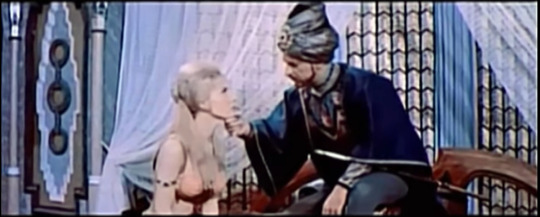
The aforementioned only exception to this cast of stock characters is the commander of the Monglings, whose name, we learn, is Amal. He is played by actor and ballet dancer Vanoye Aikens, who as far as I can tell is the only black actor in the movie. When we meet the Monglings at the beginning, Amal is the only one not wearing a helmet, and thus serves as the human face of this attacking force. After the Monglings leave, a survivor complains to Goliath that the raiders are inhuman and barbaric, and at this point I was wincing, prepared for an avalanche of early 60's racism. The fact that we then move on to an Arabian Nights Fantasy Land populated by distinctly non-Arabic actors didn't help any.
However, we do later learn a little more about Amal as a person, some of which is surprising. For one thing, he's just as terrified of Cobrak as any of the captured women are of him. For another, he considers himself crafty, thinking he can get away with keeping the prettiest girls for himself and making deals with the rebels – but he actually shows up to his conspiracy meeting drunk and it turns out that Astra already knows exactly what he does with his spare time. In a movie peopled largely with bigger-than-life archetypes, Amal is surprisingly ordinary. He’s a Dumb Thug and a Petty Traitor, but never quite the stereotype of either.
Of course he dies, but it's a pretty entertaining death. I've never seen somebody go that far out of their way to be a railing kill.
Goliath and the Vampires is sometimes slow, and it can be a little hard to tell what's going on when, say, multiple groups of characters are all wandering around lost in the same foggy swamp. But it's not so bad that it isn't any fun, and would be a good evening's entertainment for MSTies or just for people who enjoy Maciste movies. Even when it does drag a bit, you'll be rewarded for sitting through the slow stuff with something deliciously silly.
7 notes
·
View notes